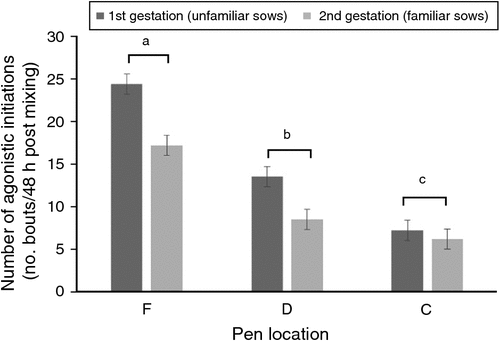Agonistic interactions in stable group housed swine using a Gestal® free access stall over two gestation periods
M. D. Pairis-Garcia A B and M. R. Campler AA Department of Animal Sciences, The Ohio State University, Columbus, OH 43210, USA.
B Corresponding author. Email: pairis-garcia.1@osu.edu
Animal Production Science 57(12) 2442-2442 https://doi.org/10.1071/ANv57n12Ab022
Published: 20 November 2017
In the United States, producers are transitioning sow farms from individual housing to group housing utilising electronic sow feeders (ESF) for delivering feed in gestation. These feeding systems represent a significant investment and require that equipment is designed to ensure individualised feeding regimens. Group housing sows inevitably results in unwanted aggression during either the initial 48 h period post-mixing (Anil et al. 2006), as a result of re-mixing in dynamic group systems or competition for resources (Jensen et al. 2000). The Gestal® ESF (Jyga Technologies, Saint-Lambert-de-Lauzon, QC, Canada) is a gated unidirectional feeder that targets loose housing sow systems, and protects sows from unwanted aggression during feeding. The objective of this study was to quantify agonistic interactions in sows housed in a stable group gestation housing system, utilising one Gestal® free-access stall with radio-frequency identification (RFID) technology during the first 48 h post-mixing over two gestation periods (first gestation = unfamiliar sows; second gestation = familiar sows).
Thirty-eight unfamiliar gilts were randomly mixed into two stable groups (n = 20 and n = 18) and housed in gestations pens (6.8 × 5.5 m) with a single gated Gestal® unit and two water nipples located on the side of the pen. The number of initiated agonistic bouts (biting, chasing, and displacing) and corresponding pen location (concrete flooring (C), drinking area (D), and feeding area (F)) were recorded for each sow continuously over 48 h post-mixing for two gestation periods (first and second gestation). Individuals were grouped into three ranked categories based on a calculated agonistic interaction index (high, intermediate and low; adapted from Galindo and Broom (2000)). Due to low chasing and displacement counts, agonistic data was pooled. Data were transformed into normality using a log10 transformation and analysed using a PROC Mixed ANOVA in SAS (v9.4, SAS Institute Inc., Cary, NC, USA). Overall, agonistic interactions decreased between the first and second gestation period (13.5 ± 1.1 v. 9.8 ± 1.1, bouts ± s.e., P = 0.005) for both pens. High and intermediate ranked sows performed a greater number of agonistic initiations compared to low ranking sows (20.1 ± 1.2, 16.0 ± 1.1 and 4.8 ± 1.1, bouts ± s.e., respectively, P < 0.0001). A greater number of agonistic initiations took place in the F area compared to C and D area across gestation periods (Fig. 1, P < 0.0001).

|
Agonistic initiations varied among sows housed in small group sizes and fed utilising a Gestal® system. This is likely a demonstration of the dominance hierarchy established within the group. Agonistic interactions decreased between gestation periods highlighting the value of stable groups compared to mixed groups. The greatest number of agonistic initiations was in the F area indicating that resource guarding is likely a major factor in inter-sow aggression, regardless of the ability to individually feed sows.
References
Anil L, Anil SS, Deen J, Baidoo SK, Walker RD (2006) Canadian Journal of Veterinary Research 70, 128–136.Galindo F, Broom DM (2000) Research in Veterinary Science 69, 75–79.
| Crossref | GoogleScholarGoogle Scholar |
Jensen KH, Sørensen LS, Bertelsen D, Pedersen AR (2000) Animal Science 71, 535–545.
| Crossref | GoogleScholarGoogle Scholar |
Supported by the Kraft Heinz Co., USA. We thank the staff at The Ohio State University Swine Research facility for their valuable help.


 ; second gestation
; second gestation  ) and area within in pen (F, feeding area; D, drinker area; and C, concrete flooring). Data are presented as back-transformed values. Superscripts indicate a difference between pen locations across gestation period (a–cP < 0.0001).
) and area within in pen (F, feeding area; D, drinker area; and C, concrete flooring). Data are presented as back-transformed values. Superscripts indicate a difference between pen locations across gestation period (a–cP < 0.0001).